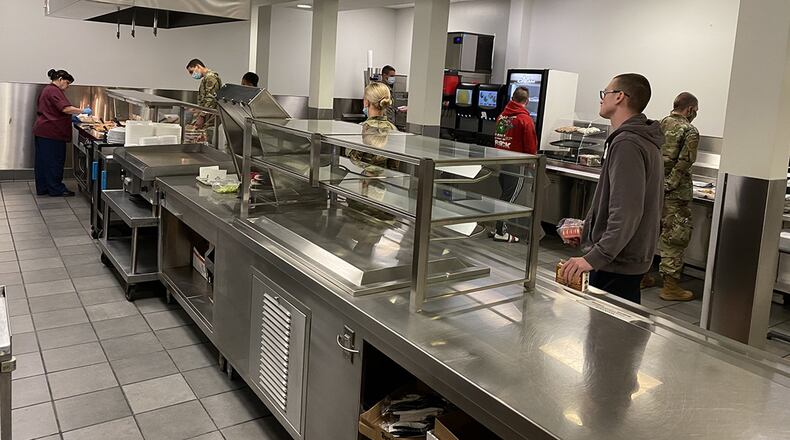That’s according to Jon Vogel, food service officer, 88th Force Support Squadron, and Staff Sgt. Steven Johnson, food service accountant.
“When COVID-19 concerns became known, we closed the dining room on March 17 and implemented a carryout-only meal option with all paper goods, and we wouldn’t need to run the dish machine,” Vogel said. “Our contractor then didn’t need to use as many employees to perform some functions, so they have been performing continuous sanitation every shift.”
Vogel said he and Johnson quickly realized they needed to determine how to implement exacting, all-encompassing safety procedures. They also needed to establish how to serve a meal to anyone quarantined due to being symptomatic. They brainstormed solutions and sent a memo outlining their policies and procedures to the Food and Beverage Division of the Air Force Services Activity in San Antonio, Texas, which oversees them.
The next day the agency implemented the Wright-Patt plan as policy, with a few minor tweaks, worldwide.
“We were a bit shocked when we saw our own procedures being sent out,” Vogel said. “That told us we are on the right track.”
“The day prior, Bill Spencer, the AFSVA division chief, had called us and asked us to send him our plan,” Johnson said.
Now Johnson types up memos – including menus – to send to Wright-Patt’s first sergeants to obtain the name and DOD ID number for quarantined service members, plus the names of individuals willing to take meals to the members.
The dining hall also has been honoring requests for units like 88th Security Forces to have their unpredictable shifts supplied with meals, he said.
When Airmen come to the facility, they usually are met by someone wiping door handles and more. Inside, Vogel marked 6-foot spacing on the serving line so Airmen would observe proper social distances as they order their entrée, starch, vegetables and more.
“We give them a timeframe during which they can call with their choices for breakfast, lunch and dinner,” Johnson said. “Otherwise we will give them ‘chef’s choice.’”
Members are still able to order a wide variety of meals that fit their preferences of being meat-eating, vegetarian or vegan. But anything that was self-serve at the dining hall, like the salad and breakfast bars and drink fountains, has been closed, with single-serve substitutes made available.
“We took those away so we’ve switched in premade salads and portioned fruit in clear individual containers,” Vogel said. “The fruit and vegetable season is starting, and we’re excited about that.”
At the cashier station, social distances are being observed while Plexiglas barriers are on order.
“We want to minimize the possibility of people being too close, so the Airmen show the cashier what they’ve chosen from a distance and scan their own card, then they are out the door,” he said.
Many Airmen sanitize their hands on the way out the door, Vogel said.
“Now that this has been in place for weeks, I think the Airmen understand and realize it has become the new norm,” he said.
About the Author
